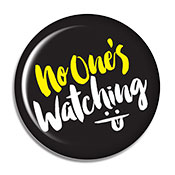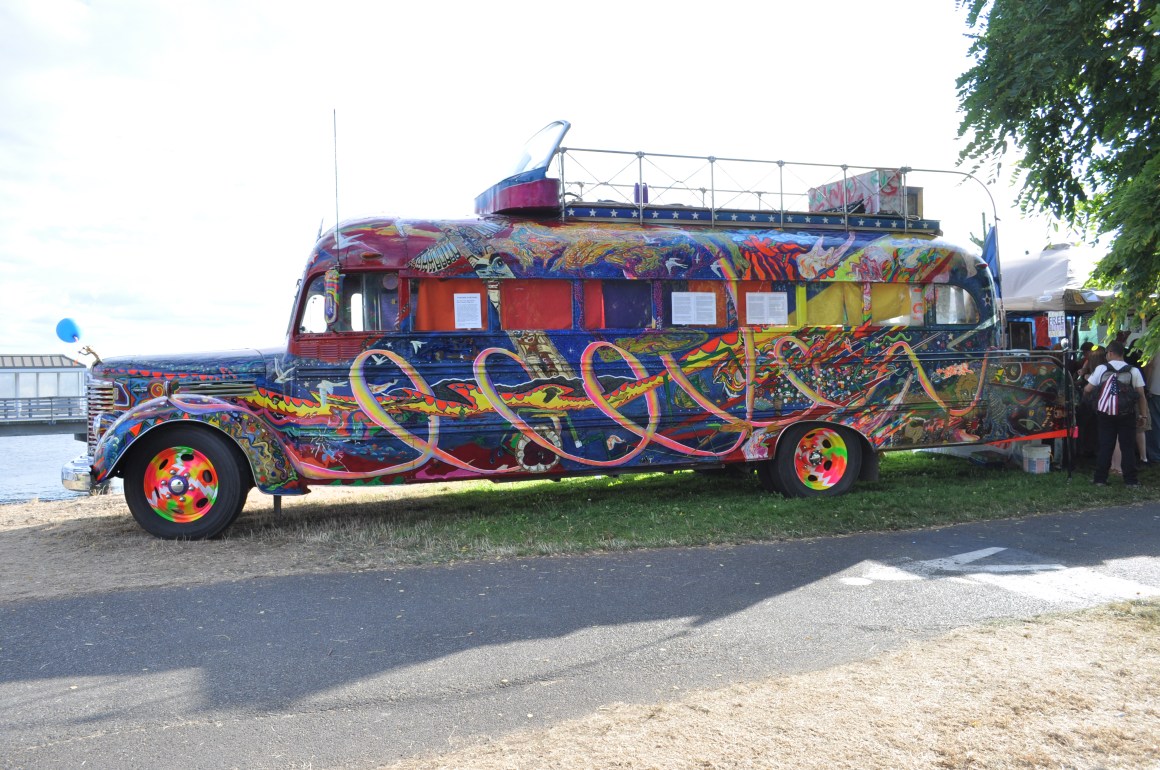
Welcome to No One’s Watching Week, the time of the year when the readers are away, and your tireless editors have run amok. For this week only, Atlas Obscura, the New Republic, Popular Mechanics, Pacific Standard, the Paris Review, and Mental Floss will be swapping content that is too out there for any other week in 2015.

The Merry Pranksters’ bus “Furthur” must have been a spectacle for Heartland yokels during its mid-1960s tour across America, and what made the trip truly revolutionary wasn’t the Day-Glo paint or LSD-fueled hijinks, but the vast amount of recording gear the Pranksters were hauling along with them. Their 1939 Harvester school bus was packed to the gills with AV equipment: cameras, microphones, lights, and amplifiers. Recording the journey seemed as important as the journey itself, and Furthur was observing itself at least as intently as were the startled squares gawking as it passed along the highway. The plan was eventually to edit the footage into a film called, with the group’s usual lysergic bluntness, The Movie.
Ken Kesey and his proto-hippies weren’t pioneering some new way to be free so much as the technology-aided narcissism of social media. Imagine a YouTube channel called “Baby-Boomer MFA Students Road Trip on Acid” and you’ll get the gist of Kesey’s project.
The bus was eventually parked and its equipment used to record the infamous Acid Tests—where the Grateful Dead (then the Warlocks) starred as the house band. With the Acid Tests, just as with the bus trip, everything was recorded. You can listen to the cacophony here on the Internet Archive, which since the mid-1990s has become a kind of central repository for recordings of Grateful Dead shows. Seasoned Internet Archive reviewer doug_the_dude comments on a recording of the 1966 Fillmore Acid Test that it’s a miracle “for ANYTHING to survive from the acid tests.” But doug_the_dude is wrong. The point of recording these ephemeral happenings was so they might not only survive, but also retain a (Benjamin-esque?) aura of authenticity by virtue of having at one point “happened.” The common conception of Deadheads is as an event-based community, locked in a permanent caravan loop rolling endlessly from show to show. But that isn’t, and can’t be, the case, not least because the band doesn’t actually exist anymore. In fact, the digital counter-tradition of what it means to be a Deadhead has long been in the ascendant through technology-based exegesis and curation of recorded materials. And the more time passes since Jerry Garcia’s death, the more being a Deadhead means streaming shows from the Internet.
It’s only a slight exaggeration to say that the Internet is a technology that was created specifically to trade Grateful Dead shows.
At this point, emphasizing the connection between ’60s counter-culture and the contemporary tech world is a tired game. It’s generally recognized that the spirit of late-’60s libertarianism helps animate the contemporary tech world—an ideological double helix comprising Richard Brautigan’s techno-utopianism and the homemade LSD street-hustle. What else could account for the modern start-ups’ quest for the trifecta of being world-saving, money-making, and effortless cool? The Grateful Dead were, of course, mixed up in the Berkeley-Palo Alto nexus from the beginning, with their Haight-Ashbury base of operations just a stone’s throw from the tech Mecca of Stanford University. Also, from day one the Dead were audio pioneers. At the Acid Tests they used LSD chemist Oswald Stanley’s Altec Voice of the Theater, a system that helped them avoid the tinny public address sounds of the time. In 1974 they created the almost freakish Wall of Sound, described by Wired magazine as using “92 tube amplifiers to push 26,400 watts through 604 speakers capable of projecting cosmic ‘Dark Star’ jams, whispered Garcia vocals, and thundering quad bass up to a half-mile from the stage without distortion.”
The connection between a Dead show and Kesey’s bus can’t be overstated. Because as incredibly loud as the Grateful Dead were, as much as they were pioneering new ways to push new sounds into the world, they were also pioneering ways to record and disseminate their performances. In direct anticipation of present-day social media, the Grateful Dead were just as interested in recording the performance as they were in performing itself: The show happened, but—equally important—it is still happening.
“Tapers,” the serious gear-heads who recorded shows obsessively as they followed the band, were always unofficially welcome (it would have required a buzz-killing police presence to stop them) and in the early ’80s they were given their own special section, corralled in front of the soundboard to keep their equipment from blocking the views of the rest of the audience. The reputation of the Dead as a live band was built on the proliferation of these tapes. And the way the band accommodated the tapers in the audience highlighted and then transcended the ephemerality of the live performance, giving it lasting meaning and context. If it had always been just about “the moment” itself, there would have been no point in encouraging the recording of thousands of shows. But they were recorded. And shared—with tapes of shows being copied and mailed out and traded.
It’s only a slight exaggeration to say that the Internet is a technology that was created specifically to trade Grateful Dead shows. Among the first few things communicated in the early 1970s on APRANET, the proto-Internet system, were: a typo someone had flagged, a bag of weed someone wanted to sell, and Grateful Dead set lists people were eager to trade. Trading Dead shows developed in tandem with the technology, eventually giving rise to websites like etree, tapersection, and NYCTaper in the early ’90s. The El Dorado of show collection, though, has to be the Grateful Dead section of the Internet Archive. Dating its first upload to 1995 (a relative latecomer to the online Dead trading scene), the site features thousands of shows, searchable by year or sound source, reviews, and a “this day in history” page.
Offering an alternative to the occasionally complicated tape-trading system, the ability to stream and download Dead shows shows the Deadheads as a community escaping the chrysalis of the physical world. Eduardo Duarte, a professor of philosophy at the Hofstra University School of Education and host of the weekly 88.7 WRHU show “Dead Zone,” describes the difference in technologies: “Collecting, or trading tapes, as we called it back in the day, was an experience that extended and thereby continued what I understand to be the core of a Dead show: the mysterium tremendum. When you attended a show you entered under the influence of the overwhelming mystery, mysterium tremendum, and with each show you took a leap of faith that the band would take the stage with the same leap. So too with the trading of tapes: insert cassette, push play, and listen for the sonic magic. You never knew what you’d hear on those analogs. Now, with the massive online digital archive the experience has become, well, archival, and more scholarly, in a sense.”
It might be heresy in Dead circles to say so, but the recordings of the shows remain just as important as the shows themselves. If the reputation of the Grateful Dead is to persist while direct experience of their shows fades from living memory, then what it means to be a Deadhead will consist primarily of an almost Talmudic archival-and-commentary effort on the part of the fans. The first Dead shows appeared on the Internet Archive as soon as Jerry Garcia died. It’s no coincidence: The music was liberated, from the weighty reputation of the band, from the corporeal bodies of the musicians, from physicality itself. It was finally free to be what it always strived to be: a gnostic unfettering from the temporal. Which is also a good description for the role of the Internet itself.


